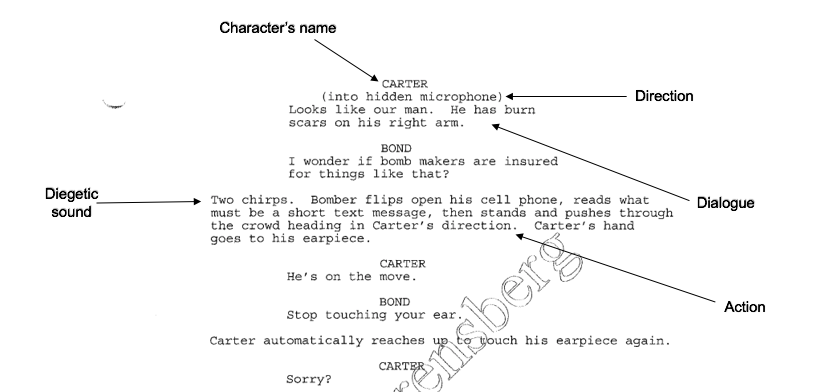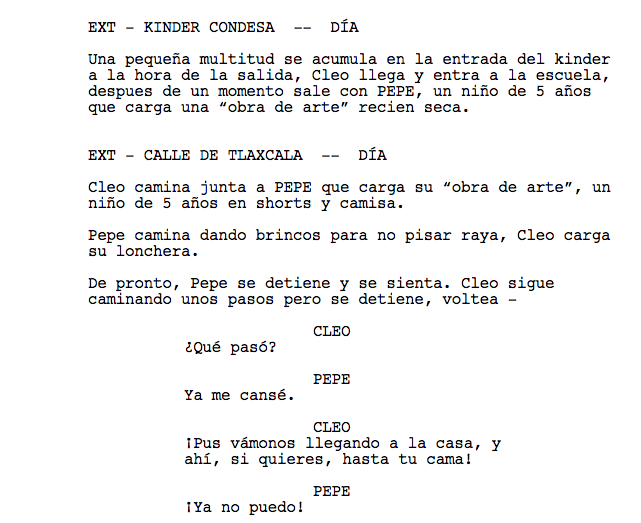Most, if not all media products are scripted to some extent, even ‘reality’ shows which claim to be completely ad libbed are heavily scripted and planned out. The following are the scripts of different media products and how they function.
Film
Film scripts document dialogue, behaviour, inflections, movement, action, setting and diegetic sound, which is sound that comes from the world within the film.

(‘Casino Royale’ (2006); Purvis, Wade and Haggis)
In the slugline of a film script, the setting is described along with whether it is inside or outside (INT./EXT.), as well as the time of day. For example:
INT. TOM’S BEDROOM – DAY
Most international films in English operate the same way, except for obviously the dialogue which will reflect the character’s origin or language. There may be a note to indicate if the dialogue is in another language to be translated later.

(‘Inglourious Basterds’ (2009); Tarantino)
The layout of foreign language films may be different as well, to fit the language it is written in.

(‘Roma’ (2018); Cuarón)
This Spanish-language script has a very similar, if not the same structure as an English-language one.
TV
While, like film, there are many different genres of TV, the different genres require different formats and structures depending on the type of TV programme it is.
DRAMA/SOAP:
(‘Eastenders’, Episode 872; Peirson)
As it is a TV show, the scene is labelled with the episode number and the episode scene number. It also says above whether the scene will be on the Lot or in a studio, or even off grounds. This is especially common for soap operas, which tend to use studios and consistent specialist sets. The formatting is slightly different compared to a film, with all the writing put to the right side of the page and no special formatting for the character’s name, more like a play script. All actions are written in capital lettering. Other than these slight differences, a TV script plays very similarly to a film screenplay and contains familiar elements.
Despite some differences, TV drama scripts are very similar to standard screenplays nowadays, with shows like ‘Breaking Bad’ and ‘Game of Thrones’ having the structure and production value of a film.
DOCUMENTARY:

Here a documentary script splits up the audio and visual elements of the picture, with narrator’s scripted voice over and scripted visuals which will be shot in the real setting of the documentary subject. These scripts are quite different, but must be as most dialogue is unscripted, specifically in interviews. Researched information and other exposition will be scripted, including shots of related action, whereas most interviews will be unscripted as the interviewee comes up with their own answers.
NEWS BROADCASTING:

Here, dialogue must be formatted to be displayed in real time during a live broadcast. There are notes on the left side and dialogue on the right, with a ‘{WIPE}’ everytime the visuals switch. The notes give messages to the production staff on the visuals and maybe to the newsreader. Unlike film or TV scripts, there is no slugline as the newsreader is always in the newsroom and no inflection as the newsreader will most likely maintain a consistent tone throughout all the broadcast.
PANEL SHOW:

Although panel shows are often mainly ad libbed, here is a scripted introduction to a panel show with a very simplistic formatting. The font and size is not consistent with most other styles, and the names and dialogue is not formatted. There is a simple introduction to what is happening in the scene, no setting description or action, with dialogue for each presenter to say without directed inflection or tone.
Radio
DRAMA:

This is very different to other styles of script. The scene is set but more liberally and simplistically than in a film or TV script. The characters are described with important details and the action of the scene. Each line is labelled with a number to help editing and overall production. Obviously because there is only dialogue, there is no detail gone into the visual description of what is happening, only the context of the scene is given.
CURRENT AFFAIRS:
This script is far less visually distinctive than other script types. The presenter and panellists are listed, then a speech or essay is written for the presenter to recite. This may spawn ad libbed discussion or may continue will information about the programme subject etc.
NEWS:
The scale of the police investigation into allegations of child abuse on Jersey is becoming clearer. Detectives say more than a hundred and sixty victims have come forward, and around forty people are now suspects — including former care workers. Search teams have also broken into a cellar at the Haut de le Garenne care home, where a child’s remains were discovered on Saturday, and say a sniffer dog has indicated there is something suspicious inside. Reporting from Jersey, our correspondent, Jane Peel:
PEEL: The police teams, forensic scientists and the specialist search dog trained to detect human traces and blood resumed work this morning. The task to get into a bricked-up cellar beneath part of this former care home. The chief investigating officer Lenny Harper said that by the afternoon they’d gained partial access to the roof.
This script type is very similar to the current affairs type. It is mainly in an essay/speech format and leaves inflection up to the news anchor. Because there are no visuals, actions are not present. The only slight distinctive element is that it shows the transition to different readers.
Computer games
Video game scripts come in different types. Some are in a flowchart model, specifically if the game gives you multiple options. Games like ‘Mass Effect’ give you multiple dialogue options which may change the story or narrative. This means that script writers must come up with multiple different pathways for every dialogue interaction.

Other games, with a standard and more simplistic linear narrative, don’t give the player many options and force them down one predetermined pathway. They will probably be unable to choose how their character responds in dialogue or physically. Games like the ‘Call of Duty’ franchise generally give the player one objective which they must follow, with little option for movement. These kind of games generally have scripts very similar to screenplays.
Open-world games have a vast amount of possible character interactions within the game, some which the character may not even reach. Games like ‘Skyrim’ have thousands of NPCs (non-player characters) around the world which will trigger a dialogue interaction and usually a separate quest, which requires an entirely separate script. The narrative and progression of these kind of ‘open-world RPGs’ is usually up to the player and therefore the script is split up and assigned to each possible interaction.

Game scripts are huge and can take massive teams of writers to complete. They are usually separated into categories and don’t follow a linear narrative pattern.
Game scripts will also contain programmed events (e.g. whether the mode is PvP or PvE), identifying important rooms and what in the setting is immutable or destructible. You must also include diegetic and non-diegetic sound in a game script, like in a screenplay.
There are many types of script in media. Some, like screenplays, require a very specific structure and formatting, whereas others, like radio scripts, are more liberating and don’t require arbitrary rules.
